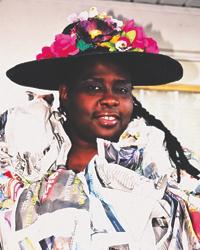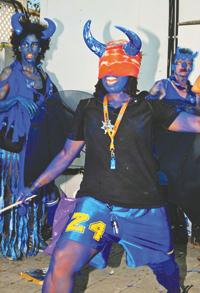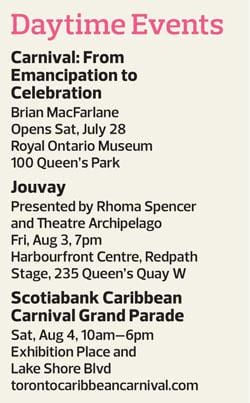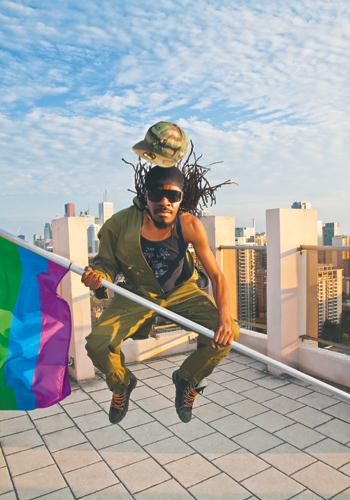
Rhoma Spencer as the paper doll, a living newspaper who sings about the scandals of the day. Credit: Marsha Edwards

A dancing blue devil. Credit: Marsha Edwards

Credit: Marsha Edwards

Credit: Marsha Edwards
The Scotiabank Caribbean Carnival weekend has never offered more to queer people. Although the organization itself doesn’t put on any events specific to this community, gay parties and events on the periphery of the parade and festivities continue to grow every year.
Enter DJ Blackcat, a gay Jamaican-Canadian promoter who has been hosting and playing at queer events for black, Caribbean and other communities in Toronto for more than 20 years. According to him, there’s been a recent explosion of enthusiasm for the parties he throws on what is known to many as Caribana weekend.
This year is no exception, and Caribana weekend will be full of parties hosted by Blackcat and others, including an all-women’s party at Harlem Lounge and the House of Monroe’s outdoor Summer Sizzle Ball on the Zipperz patio. Blackcat expects them all to be huge.
“Last year and the year before we did over a thousand people on the Sunday night,” he says. “And it isn’t just black people at the events, which is amazing to see. The white kids are loving me now, and the ladies are loving me.”
In past years, Xtra has written about the parallel tensions of Caribana: many Caribbean gays and lesbians and other people of colour don’t feel comfortable in white-dominated queer spaces, while gay people don’t always feel welcome or comfortable in Caribbean spaces, which are often perceived as homophobic.
But Blackcat sees the increasing popularity of his and other events as evidence of emerging mutual support. The organizers of the parade and other official Carnival events tend to agree that people are more willing than ever to celebrate the two cultures together.
“I think it’s not that the Caribbean has changed but that the Caribana people have changed,” says Stephen Weir, a representative of the Carnival. “Most of the people running the camps can trace their roots back to Trinidad, but they are Canadian, and they are very much part of Toronto in terms of a willingness to be all-inclusive, whereas maybe 30 years ago that wasn’t the case.”
Councillor Joe Mihevc, who has long been the festival’s liaison to city hall, also has hopeful, if hesitant, comments on the issue.
“Of course, homophobia is present everywhere, and it is present in the broader festival community. But I think that there will be an openness and a reception and a willingness,” Mihevc says. “The LGBT involvement in the festival is a new experience, and it will stretch the imagination of the community. That’s a good thing.”
As for attending the parade, Blackcat says being out has never been a problem for him.
“I’ve not had an incident; I’m very comfortable going to the parade,” he says. “I know a lot of people who go to Caribana and who are very comfortable with who they are and don’t have any problems.”
By these accounts, it would seem queer people are finally staking a space in the Carnival parade and broader community. However, the experiences of other participants and Carnival organizers tell a different story.
Rhoma Spencer, a queer Trinidadian-Canadian Carnival performer, has been organizing Caribana events for years, including an opening parade celebration called Jouvay (a play on the name of the traditional carnival opening event, the J’Ouvert, itself a Creole corruption of the French jour ouvert — “day opening”), to be held at Harbourfront Centre this year. Spencer says her sexuality has not gotten in the way of organizing in the Carnival community, though it can be a source of tension.
“Some people know that I’m a lesbian, some don’t. I’m still aware that in that Caribbean space, some people will be prejudiced, so I’m not going to call attention to myself,” she says. “It doesn’t stop me from being a part of anything that has to do with a Carnival, because it’s my culture.
“A lot of our queer presence is not visible in the Carnival in Toronto. They don’t feel welcome. They are present in all of the bands, but they are not outwardly gay. You would hardly see a man jamming up on a man going down the Lake Shore without it being frowned upon or made a spectacle.”
Even so, Spencer recalls her own visible intervention in 2006, when her ole mas (traditional costumes) band had a section of classic blue devils played by lesbians and transgender people, some of whom still participate in the parade.
Jamea Zuberi has been a bandleader in the parade for 23 years and agrees that visibility is an issue. Zuberi, who identifies as queer, organizes the Pelau Masqueerade, a Carnival-inspired mas group that marches in the Pride parade to great success. Even so, she is hesitant to bring something like Pelau to Caribana.
“I personally still think it’s not safe enough,” Zuberi says. “There was a rumour [of a queer mas band] one year, and the rumour was really not taken well. So can you imagine if this were real?”
What is clear, at least, is that there is nothing new about queer involvement in Toronto’s Carnival, nor in the Trinidadian Carnival tradition that inspired it.
“In any band you will see LGBT people in the costumes, and ‘flaming’ ones, if I can use that word in quotes — you can tell people are LGBT-identified,” Zuberi says.
“The machinery, the architecture behind the Carnival has always had a strong LGBT presence, whether outwardly so or closeted,” Spencer adds.
Indeed, performers like Spencer and Zuberi are quick to mention that the most popular mas artists in Trinidad, such as Peter Minshall and Brian MacFarlane, are gay. This year the Royal Ontario Museum has invited MacFarlane to do a Carnival exhibition, opening July 28.
Even beyond these crucial gay individuals, the Carnival tradition itself has many queer aspects.
“Crossdressing has always been a big part of J’Ouvert and ole mas, and in no time during the carnival do you not see people crossdress,” Spencer says. “Carnival is a time where we are allowed for that two days to strip ourselves and reveal who we really are.”
Zuberi says Carnival has been a liberating experience for friends of hers undergoing gender transition. “A man saying, ‘I am going to go in a female costume, and you are going to tailor a female costume to fit me and my genitals,’ is an act of resistance,” she explains.
Indeed, one of the J’Ouvert performance’s most popular characters — the planter’s wife, Dame Lorraine — is always played by a man. And to add to the playful sexuality of the J’Ouvert, which emerged from emancipation celebrations in Trinidad, Dame Lorraine and many characters have comically exaggerated genitals and gender markers.
Zuberi also emphasizes the way in which Toronto’s Black Coalition for AIDS Prevention is extremely visible as a queer-positive presence along the Lake Shore Blvd parade route.
So, if there are so many queer people producing Carnival celebrations, in Trinidad and in Toronto, and if so much about the celebration itself has queerness running through it, the question arises: why isn’t there a queer mas band or queer party with an official link to the Carnival organization?
Cassandra Lord, a PhD student and researcher at the University of Toronto, wants to reconsider how, and why, that question is asked. Lord, whose work follows the Pelau Masqueerade and the experiences of people of colour at Pride, wonders if it’s even productive to apply the same standard of visibility to the Caribbean Carnival that we do to Pride.
“Is it that we want to see people with a flag, or with a banner? Is it possible that it could look differently from how we think about queerness from a North American perspective?” Lord asks. “It’s important to have that representation there, but I don’t think it has to look the same way. We could create something that could be there that didn’t come out screaming, but which has eased its way in.”
Nobody is exactly sure how this kind of progress might manifest. DJ Blackcat, for one, imagines a street fair on Church St that could run alongside the Caribbean Carnival. Yet even he has his doubts about how that would happen.
“I think we’re asking for these things, and we’re not ready for what that will entail for us sometimes,” he says. “If it’s going to happen it will be a group of people, some that are in the party scene, some that are more politically aware . . . But I think it can happen, and I think it can happen in my time.”
For Spencer, too, it’s going to take something really big.
“The only way that the Carnival here will seem to be a welcoming space for queer people is if, for instance, Toronto Pride itself would have a float or a band in the guest band category, which is for community organizations,” she insists.
“So much of what goes on in Pride today is a carbon copy of the Carnival: the notion of music trucks, of costumes. Pride should take on the job of partnering with the Carnival one year and come down the Lake Shore to promote the work of Toronto Pride, and so doing, the Carnival will be making a statement that hey, we welcome you.”
The challenge stands.

 Why you can trust Xtra
Why you can trust Xtra


